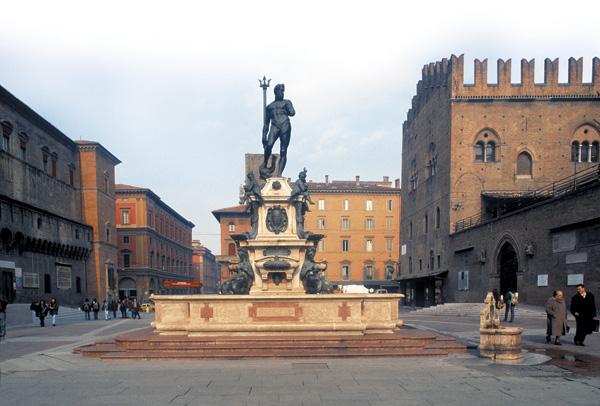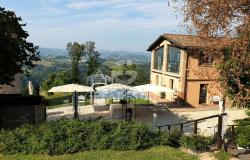No word can do more to excite the interests of Italian epicures than the name Bologna, a city rich in its associations with all that is great in Italian cooking. No wonder it has earned the nickname, La Grassa or ‘The Fat’. Incredible tortellini, fragrant cheeses and prosciutto, amazing food shops, restaurants and markets all conspire against a trim waistline. However, before we get too carried away with gastronomic matters, we also have to remember that Bologna is one of the richest cities in Italy in terms of art and architecture and a walk around its compact centre is a great pleasure, taking in its exquisite sites and building up an appetite for the superb meal that will inevitably follow.
The city has evolved from an Etruscan town into a world centre of learning, a hotbed of left wing politics and, more recently, an important focus of high technology. Along the way its has acquired superb buildings, distinctive for their long porticoes and the reputation for all that is wonderful in the culinary world. This is a great place to explore on foot and even if you are unlucky with the weather you can keep to the 40 kilometres of arcaded pavements that allow you to explore the city under cover. As the first Italian city to restrict traffic in the main parts of the city centre, the roads are noticeably quiet and, even though the city is one of the most beautiful in the country – some say second only to Venice – it is also remarkable that it isn’t overwhelmed by tourists like many of the more popular Italian destinations.
Going Up in The World
The centre of the ancient city is marked by a pair of tall brick medieval skyscrapers: the Torri Pendenti, the last two remaining from a period when about 200 such buildings rose above the city around the Porta Ravegnana. The tallest is the rather spindly looking 97-metre Torre Asinelli and you will certainly have done enough to deserve your antipasto if you climb the 498 narrow winding stairs to the top, where you will be rewarded by a stunning view of the city and the Apennine landscape beyond.
If you still have full use of your legs once back at street level, you might walk down the Strada Maggiore to the 14th-century church of Santa Maria dei Servi to see the Cimabue Madonna and Child panel and the frescoes by Vitale da Bologna. In the same street you will find the Corte Isolani, a 13th-century palazzo that houses the British Council as well as a contemporary art gallery, bars, cafes and elegant shops in its series of connecting arcades and courtyards. In a nearby street large numbers of students like to hang out in the warmer evenings, making you realise that the city, home to one of the oldest universities in Europe, is populated by over 90,000 students. A short walk to just south of Piazza Cavour brings you to one of the other great churches of the city, San Domenico, arguably the most important Dominican church in Italy, with the Saint’s body reputedly buried beneath the magnificent Arca di San Domenico featuring the work of Nicola Pisano and early figures by Michelangelo.
Culture and Cuisine
To feel that you will fully deserve both a pasta dish and a main course, gird your loins and cut through one of the side roads to reach Via Zamboni which leads to the heart of the university area centred around Palazzo Poggi. This is a very lively and attractive part of Bologna, featuring endless successions of porticoes crammed full of fine restaurants, pizzerias and bars. The road also takes you to Via delle Belle Arti, home of the Pinacoteca Nazionale where there is an impressive collection of 14th-century Emilian painters like the Carracci brothers, Guercino and Guido Reni as well as works by Raphael, Giotto, Titian and Perugino.
Returning to La Grassa for a moment, the Trattoria Belle Arti at number 14 is a relaxing place to have a reasonably priced lunch or pizza. At Piazza Rossini is one of the jewels of Bologna’s art: the Gothic-Romanesque church of San Giacomo Maggiore which contains the Capella Bentivoglio dating back to the 15th century and featuring a glorious tomb by Jacopo della Quercia as well as superb frescoes by Costa.
Meanwhile if you still haven’t solved the nagging question of lunch, running off Via delle Belle Arti is Via Mascarella where you will find a good restaurant Cantina Bentivoglio at 4B which has live jazz. Wherever you choose for lunch, look out for some of the regional speciali-ties for your main course, maybe cotoletta alla Bolognese, a breaded veal cutlet covered with a mixture of prosciutto, Parmesan cheese, mozzarella and grated truffle or the famous Emilian zampone con le lenticche, pig’s trotter stuffed with a mixture of minced pork, lentils and spices, traditionally eaten throughout Italy at New Year, when the lentils represent coins, signifying wealth in the coming year.
Nymphs and Neptune
Assuming you enjoyed the lunch, it is time to take a little exercise and even make space for the evening meal. The true centre of the city is found in the twin spacious squares, Piazza Nettuno and Piazza Maggiore. Piazza Nettuno, needless to say, is home to the particularly impressive Neptune’s Fountain by Giambologna, who created well-endowed sirens spouting forceful jets of water and the muscular figure of Neptune who appears to have been making early experimentation with steroids. Rising up alongside the fountain is the Palazzo Communale, also known as the Palazzo d’Accursio which contains the Museo Giorgio Morandi, named after the 19th- century painter. The adjacent Piazza Maggiore is dominated by the massive shape of San Petronio, Bologna’s Gothic duomo. Its art and interior ornamentation are evidence of the city’s wealthy history. Its unfinished facade is part-covered in marble with reliefs by Jacopo della Quercia; the original plan had been to build it larger that St Peter’s in Rome, but funds ran out and the ambitious plans had to be scaled down. Opposite the duomo is the imposing Palazzo del Podestà, the former Governor’s Palace.
Where to Shop
As well as having plenty of cultural sites to visit, this part of the city is great place for shopping. Those interested in food should explore the amazing collection of shops and stalls around Via Caprairie, Via Drapperie and Via Pescherie, just a stone’s throw from the Piazza Maggiore. Shopkeepers take great pride in how they display their food and the quality of the produce is wonderful to see. Whether it’s fish, cheese, fruit, vegetables, pasta or meat, the mind boggles while the stomach beckons. While most of it is unlikely to survive the journey home, it may be worth buying a chunk of Parmesan cheese or some dried porcini mushrooms or home-made tortellini. Although always associated with Modena, balsamic vinegar actually originated in Bologna and you may be lucky enough to find a rare treat: chocolates filled with sweet 40-year-old balsamic vinegar, a most incredible combination of tastes. Look out in particular for Bologna’s most famous food shop, Tamburini, found on via Caprarie 1 where the family has been selling the finest pasta, hams and cheeses since 1932 and a similar establishment has been here for centuries. It is easy to spot this shop as there is always a nun sitting outside collecting for charity.
If you miss the balsamic-filled chocolates, typical Bolognese desserts are torta di noce (walnut cake), budino di mandorla (almond pudding) or torta di tagliatelle, a crunchy cake made from strands of pasta. If you are confident that your waist size is not going to change colossally during your visit, there are tempting clothes shops all around Bologna but especially around Via Azeglio and Via Farini, where all the familiar Italian names are to be found along with some less familiar ones. There are old-fashioned shops selling hats, as well as haberdashers, handmade shoe makers and shops that will make you up a shirt from a dazzling array of superior materials. The Arcade Cavour also has some beautiful shops, as does the Portico del Pavaglione and it is a pleasure just to ogle the windows in this part of town and think about how you might look if you could squeeze into the skimpy designs that are on display.



